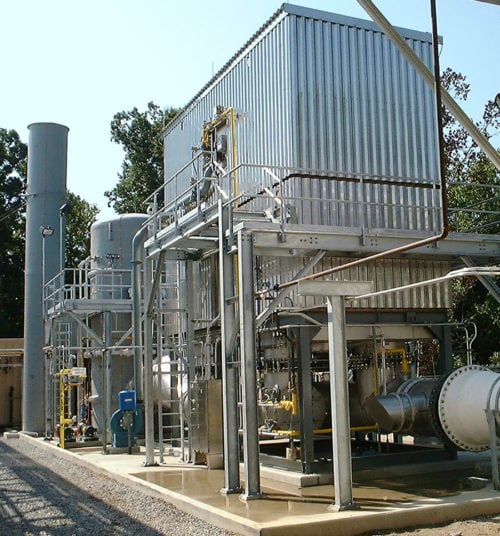Summary
In the Rendering Industry, odor control equipment has been in use since the early 1970’s about the same time Anguil was formed and started serving clients
As technologies evolved, fire tube boilers that utilized the waste heat of the afterburners were added to produce steam for the steam intensive plant process. The use of the waste heat boilers were the first step in heat recovery of the afterburner. The addition of the waste heat boiler to an afterburner would typically make the overall system efficiency of the two components in the high 70% to low 80% range. However, the overall system efficiency was only this high if the total production of steam from the waste heat boiler was constantly used. Intermittent use of the steam production severely lowered the overall system efficiency and increased the operating cost.
Other applications of different technologies included the use of Thermal Recuperative Oxidizers, which utilize a shell and tube stainless steel heat exchanger. The Thermal Recuperative Oxidizers were not used with waste heat boilers due to their lower outlet exhaust temperatures, but still utilized Economizer units for pre-heat of make-up feed water. Typical heat recovery performance of a shell and tube heat exchanger was around 60 – 70%. The lower efficiency of the shell and tube type heat exchanger vs. a waste heat boiler still averaged to a lower annual operating cost on applications were large boilers were already existing, and steam generated by a waste heat boiler could not be utilized on a continuous basis.
The Challenge
Rising energy costs and the social pressures for improved Environmental Social Governance (ESG) around one of the oldest recycling industries, Rendering, has led to the need for implementation of better environmental controls. With residential areas encroaching on Rendering plants, odor control of storage, loading, grinding, and transport areas has become important. The larger air flows associated with controlling these areas make the use of higher efficiency technologies a must in order to conserve energy and meet today’s carbon reduction goals.
The Solution
Regenerative Thermal Oxidizers (RTOs) are becoming more commonplace to solve these challenges, but the importance of an experienced team to supply this
The Result
With the multi-stage solution, the initial Venturi Scrubber uses a centrifugal action to ready the gas stream before entering the first-stage Scrubber that treats the ammonia. Leaving the top of the initial packed tower into the bottom of the Hydrogen Sulfide second-stage section, the waste gas is further prepared for final treatment of Volatile Organic Compounds (VOCs) and Hazardous Air Pollutants (HAPs). A three-canister RTO provides a means to eliminate a short duration “puff” of untreated odors from the RTO during valve cycling. With such high intensity odors in a Rendering application, it is vital to remove greater than 99% of any entering waste components. Leaving the exhaust stack of the RTO, final regulated emission levels are met while minimizing CO2 production with the highly energy efficient RTO technology.
Project Highlights
- Stainless steel material is used to maximize equipment life when exposed to incoming acidic gas streams
- Specially designed ceramic media heat recovery beds in the RTO to better resist particulate plugging
- Properly sized burner and combustion chambers for maximum performance and flexibility for fluctuating operations
- Proven controlled bake-out program to clean RTO ceramic media to maintain optimal performance


